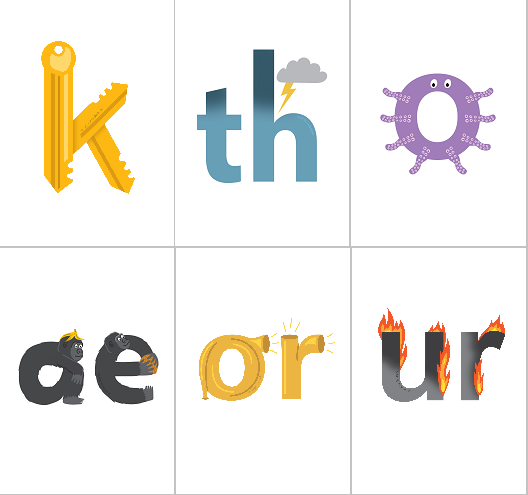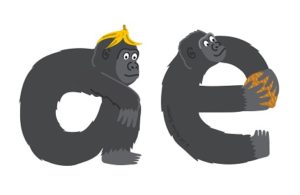New things at Spelfabet
20 Replies
The COVID-19 pandemic knocked most of my plans sideways and sent me into too-tired-to-blog mode for most of the last year, but here are five new things we’ve been working on:
- Intensive school holiday and Saturday groups for ages 6-8
- New, improved Embedded Picture Mnemonics (Aust/UK and US versions)
- Version 3 Spelfabet workbooks
- Local Community of Practice (INMELLCoP)
- Decodable text writing interface
Intensive school holiday and Saturday groups for ages 6-8
If you know a young struggling reader/speller in Melbourne who might like to attend our intensive phonemic awareness and phonics holiday or Saturday groups, the details are here.

New, improved Embedded Picture Mnemonics
I hope to have Version 2 of the Spelfabet Embedded Picture Mnemonics on the website in the next couple of weeks. The main changes are:
- The pictures on the poster-size mnemonics are bigger.
- There are two versions, one for speakers with an Australian/UK (non-rhotic) accent and one for speakers with an American (rhotic) accent. If you speak something else, please feel free to get both versions and mix and match. Both versions now have “o as in octopus” (not orange) and “or as in horn” (not corn, some kids don’t do vegetables). The US version has an extra “aw as in claw” and “wh as in whale” (needed for some dialects), no “air” or “ear”, and the woman on the US “oi as in coin” mnemonic is not a queen.
- Both new sets have “k as in key” instead of kangaroo, “ur as in burn” instead of surf, and “u as in up” instead of undies, to make them more relevant outside Australia.
- More target sounds are in initial position without adjacent consonants – “th as in thunder” not path, “th as in themselves” not weather, and “f as in fish” not flower.
- The “long vowel” mnemonics all end with a letter “e”: “ae as in ape”, “ee as in bee”, “ie as in tie”, “oe as in toe” and “ue” as in statue” (the newts were too obscure). I realise that ape is not spelt “aep” but these mnemonics primarily represent phonemes not just graphemes, and
 I decided frequency of use (see the Edward Fry phoneme-grapheme count) plus the relationship between ‘long’ and ‘short’ vowels (as in volcano-volcanic, athlete-athletic, child-children, episode-episodic and introduce-introduction) were more important. Also, one of the apes has a banana peel hat, what’s not to like about that?
I decided frequency of use (see the Edward Fry phoneme-grapheme count) plus the relationship between ‘long’ and ‘short’ vowels (as in volcano-volcanic, athlete-athletic, child-children, episode-episodic and introduce-introduction) were more important. Also, one of the apes has a banana peel hat, what’s not to like about that?
Many thanks to the wonderful Cat Macinnes for the new artwork. If you’ve already bought Version 1 of the Embedded Picture Mnemonics, you will be able to download Version 2 without having to pay for them again. Any problems, let me know.
Version 3 Spelfabet workbooks
I almost have the first four of a new set of Spelfabet workbooks ready to put on the website. These in general follow the Sounds-Write / Phonic Books / Forward With Phonics teaching sequence, which we’re now using with most of our clients.
However, we’ve found that a lot of our clients need more explicit teaching about how to add prefixes and suffixes to words, and a more gentle gradient from the Initial Code into the Extended Code. We work with many learners with additional needs (speech-language disorders, intellectual and attention difficulties, autism spectrum disorders, low working memory and slow processing) so I’m hoping that the new workbooks will be of use to others working with such learners, and to teachers who just need a bit of additional material to make sure a particular skill or concept is practised to mastery.
The new books should be on the website in the next two or three weeks (she said. There. Now I have to focus and finish them).
Local Community of Practice (INMELLCoP)
We’re now reviving the inner northern Melbourne Early Language and Literacy Community of Practice, which also got forced onto the back burner during the COVID-19 lockdowns. We had our first PD activity of the year this week, a session about phonemic awareness.
INMELLCoP now has a page on the Spelfabet website (till it’s grown enough to have its own website) where we’ll publish a schedule of meetings/workshops for the rest of the year soon.
Decodable text writing interface
For a few years, my excellent webmaster Nik Dow and I have been talking about creating an interface that will help people write decodable text.
The idea is that you’d be able to specify the sound-spelling relationships and high-frequency words you’ve taught, and then type your text, and the interface would give you a decodability rating for it. It would also highlight words that are harder than the code you’ve taught, and (one day when we get really flash) suggest synonyms with simpler spellings.
If we can make this work, teachers will be able to type/paste in text to check whether it is decodable enough for their class. Children’s authors will be able to use it to write decodable text without needing linguistics expertise – the computer will do the hard part for them, and they’ll be able to focus on creating wonderful stories.
We’re working on the Sounds Write/Phonic Books sequence and highest-frequency words at present, and then we’ll start coding my school dictionary. Then if that works we’ll seek to expand the interface to other teaching sequences. Wish us luck!



Awesome! I’m very excited about the decodable text interface.
Hi Alison,
I was excited to see your updated mnemonic alphabet- this is one of my favourite resources and often recommend it to colleagues. I can’t figure out how to access without purchasing again though. I have done this as I think it’s a way of recognising the amazing contribution you are making but you may want to think about some step by step instructions fort others. Thanks!
Actually sorry just reread and realised it’s not available yet- probably why I couldn’t access! Please ignore my gaff (:
Looking forward to all of this goodness!! Thank-you so much for all your work 🙂
I’m just curious why no longer mnemonic cards for ‘air’ and ‘ear’?
Thanks!!
The ‘air’ and ‘ear’ mnemonics are still in the Australian/UK set but aren’t in the US set, as they pronounce final /r/, so these are not diphthongs in a US/rhotic accent. Hope that makes sense! Alison
I am SOOOO super excited about the decodable text interface. I spend perhaps over a hundred hours over a couple of years trying to make something very similar to what you are describing work, but the database/programming skills were beyond me, so I had paused the idea. Very excited to see that you are doing this! If there are any semi-trained monkey hours that need to be put in for this, I’m happy to volunteer my time.
Kathy that’s amazing, I’m so pleased someone else had the same kind of idea, the coding skills are also well outside my area of expertise, I’m just hoping my webmaster and his team can do it. Re the monkey hours, I will definitely let you know if there are words needing coding, it’s a bit of a slow job and needs linguistics expertise, which I think you have (are you the Katherine Weeden who is also on DDOLL?). All the best, Alison
Hi Alison, I really love your mnemonics. Just wondering if you’d consider making t more of a tall letter, like h?
Regards,
Edwina
I think the interface is already done. Here is the website https://www.icanreadwithoutyou.com/ I believe it has a patent too. I noticed it on Facebook.
Love your work
Wes
I had a look at the I Can Read Without You website and it looks very different from what I’m working on, but thanks for taking the time to tell me about it. All the best, Alison
I have already bought the first version of the picture embedded alphabet and love it. I use it all the time and use the picture as my key word for the grapheme-phoneme, /u/ for undies is the most popular by far and always brings a smile to the faces of the students. Would it be possible to do a picture embedded into the grapheme ‘ck’, I’m thinking of a duck? It is not possible to use the ‘c’ and ‘k’ together as the keywords of the pictures do not correlate with words that use the ‘ck’ grapheme when word building.
Hi Janette, /k/ is the only sound represented more than once in the set (c as in cat, k as in key, q as in quilt, and it’s also one of the two sounds in x as in box) but I’m generally only representing each sound once, the idea is to represent PHONEMES not GRAPHEMES, I’d need to make 100+ mnemonics if I was representing graphemes. By the time children are ready to learn digraphs they shouldn’t need the mnemonics any more, they are just to help them get started in remembering the letters and understanding that there are more sounds than letters.
You are amazing!!! Thank you for all you do to help children and teachers!
Sounds Write/Phonic Books sequence and highest-frequency words will be incredibly useful and can’t wait for it! Thank you for all the amazing work!
This sounds wonderful Alison. Will the workbooks be editable or n Sassoon font at all? Hoping that the answer to this might be yes!
I’m still making the workbooks in Boardmaker, and changing fonts in that is a nightmare, and Sassoon is a proprietary font which would mean I’d have to negotiate a contract with them, which would be complicated. So at this stage, no, they won’t be able to be changed into other fonts, sorry
This would be brilliant, Allison. If it was also possible to code longer books in this way, this would be invaluable. I’m thinking of say an Enid Blyton book, Magic Tree or more modern stories. Books with more sustained reading are an effective way of acquiring orthographic mapping – a bridge between serious and sustained reading and decodable books. imo ‘competent early decoders’ are helped, not harmed, by sustained reading with richer content, more layered vocabulary, and they also develop a habit of sustained reading. Sometimes a programme/teacher may keep children for too long within decodable book constraints and while doing extremely well up to age 6/7 (phonics screening check level) children can perform less well when the transition to more sophisticated literacy happens. (I speak as a passionate promoter of decodable books , particularly when they actively discourage guessing via words that to an habitual guesser look similar but act as a ‘break’).
Thanks again for all your intelligent, lively and accessible work. g
Wow to every piece of news above, Alison. I was going to say you’re amazing but, given that’s the word everyone has used, I’ll use these synonyms instead: astonishing, astounding, awesome, sensational, remarkable, spectacular, stupendous, phenomenal, prodigious, extraordinary and incredible.
Thank you for *everything* you do to advance evidence-based approaches to reading.
Ria, that’s very kind, thankyou so much, our admin person is trying to teach a few of us to accept compliments, so I will bask in your kindness, and just say I’ve had a LOT of help with everything and there are a lot of awesome people, I’m sure you’re one of them. I hope that you’re surviving the latest lockdown, and that it is of short duration. All the best, Alison
Thank you for linking the Fry paper–that is a treasure of info–much appreciated!